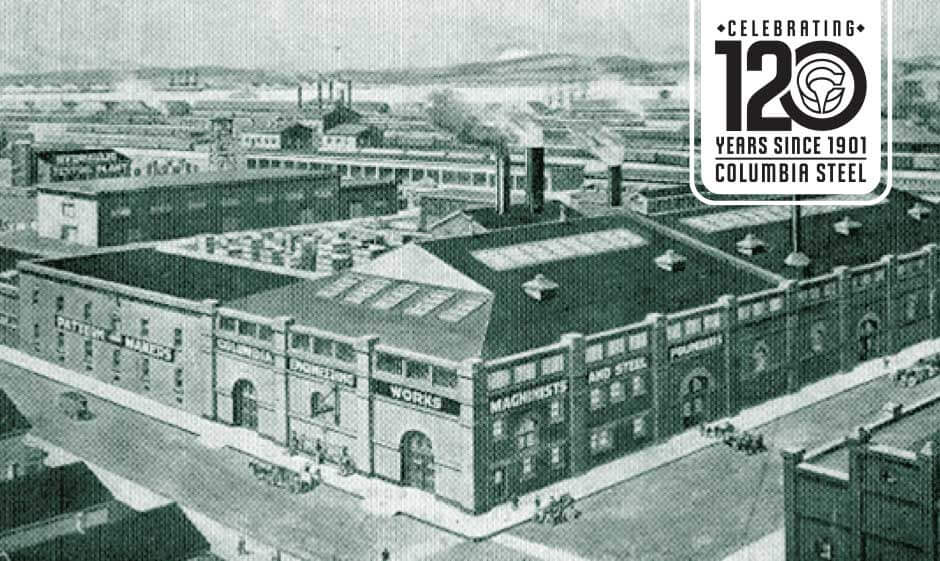Walk With Us Down Memory Lane in Celebration Of Our 120th Anniversary
The world looks much different today than it did in the early 20th century. Many of the day-to-day activities we take for granted would have seemed like magic to the people who lived all those years ago. Those innovations have even made their way into foundry work, which is the beating heart of Columbia Steel. However, many of the fundamentals of our work remain unchanged from when our doors first opened back in 1901.
Throughout twelve decades of operation, Columbia Steel has continued to produce high-quality wear parts from our headquarters in Portland, Oregon. Generations of workers built that longevity on the bedrock of a dedication to an ancient craft dating back thousands of years. As we mark our 120th anniversary, we’re looking back at our company’s founding and early growth that mirrored Portland’s rise as the region’s commercial center.
1901 – 1910: Founding and Early Growth
The City of Portland has come a long way in 120 years. Back at the turn of the 20th century, our city had the reputation as a dirty and dangerous port town set on the outskirts of American civilization. However, Portland was thriving. Home to more than 90,000 people, Portland was the largest city in the region and served as the economic hub for much of the mining, timber and agricultural work throughout the west. These natural resources held the promise of enormous riches, and the companies working to harvest them needed a constant supply of machinery and spare parts.
Despite its rapid growth, Portland was still a very isolated city. With highway and air transportation still decades away, companies were forced to ship the supplies they needed from San Francisco or have them brought by rail from the east. This growing demand created an opportunity for a few enterprising people to fill the gap.
In 1901 a group of businessmen formed Columbia Engineering Works, which became the first steel foundry west of the Mississippi River. Samuel Maxwell Mears — our first president — set out to lead the company as it made machine parts for logging, water rams for irrigations and steel castings for mining. In 1904, a Californian named W.P. Hammond purchased Columbia Engineering Works to supply dredge parts for his gold mining operations. Later that year, the company moved to N.W. Johnson Street in the block between 9th and 10th — a location it would occupy until 1962.
Portland saw a tremendous population boom thanks to the Lewis and Clark Exposition of 1905, which marked the exposition’s centennial anniversary. During its four-month run, more than 1.6 million people visited the city. In the five years following the show, the city’s population grew to more than 270,000 people. This growth fueled even greater demand for steel cast parts, which kept Columbia Steel busy producing steel railroad track switches, ship parts, gold dredges and industrial machinery components.
1911 – 1920: Industrialization Drives Further Growth
The company’s growth continued as Columbia Steel entered its second decade. The Port of Portland and the Army Corp of Engineers dredged the Columbia River channel to a depth of 26 feet, which allowed bigger ships to visit the city. Railroad construction continued to expand, and the demand for crushed aggregate for road bases grew as more Americans bought automobiles. As a result, Columbia Steel began filling orders for rock crushers and the newly-developed steam shovel.
Alexander M. Clark became the company’s general manager in 1911. Five years later, a young man named Hobart M. Bird joined the foundry team after serving in the Oregon National Guard. In 1917, Mr. Bird left Columbia Steel to enter the United States Army and serve in World War I, where he earned the Distinguished Service Cross. The company kept a position open for him, and when Mr. Bird returned, he joined the maintenance crew and was soon promoted to foreman. Eventually, Mr. Bird would become president and owner of Columbia Steel, followed by his son, Hobart “Bud” Bird — former chairman of the board — and granddaughter Martha Cox, our current CEO.
The 1920s and Beyond
The Roaring Twenties would bring more growth to the City of Portland and Columbia Steel. However, a looming economic depression meant that unprecedented challenges were also on the horizon. Fortunately, a former maintenance foreman turned enterprising salesman by the name of Hobart M. Bird would help the company find its way.
The Columbia Steel story will continue — stay tuned for future entries in this series.
